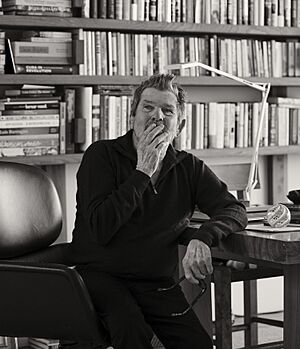Jann Wenner facts for kids
Quick facts for kids
Jann Wenner
|
|
|---|---|

Wenner in 2023
|
|
| Born |
Jann Simon Wenner
January 7, 1946 New York City, U.S.
|
| Spouse(s) |
Jane Schindelheim
(m. 1967; div. 1995) |
| Partner(s) | Matt Nye (1995–present) |
| Children | 6 |
Jann Simon Wenner, born on January 7, 1946, is an American businessman. He is best known for co-founding Rolling Stone magazine. This magazine focuses on popular culture, especially music. Wenner also used to own Men's Journal magazine.
While attending the University of California, Berkeley, Wenner took part in the Free Speech Movement. He started Rolling Stone in 1967. Later, he helped create the Rock and Roll Hall of Fame. As a publisher, he has been a very important figure in media.
Contents
Early Life and School Days
Jann Wenner grew up in the San Francisco Bay Area. His parents divorced in 1958. After their divorce, he and his two sisters went to boarding schools. He finished high school in 1963 at the Chadwick School.
Wenner then went to the University of California, Berkeley. He was active in the Free Speech Movement there. This movement supported students' rights to speak freely on campus. He also wrote a column for the student newspaper, The Daily Californian. Wenner left Berkeley in 1966.
Starting a Career in Media
Jann Wenner got a job at Ramparts magazine. This magazine was known for its investigative reporting. His mentor, jazz critic Ralph J. Gleason, helped him get this job. Gleason was an editor at Ramparts, and Wenner worked on a newspaper that came from the magazine.
Founding Rolling Stone Magazine
In 1967, Wenner started Rolling Stone magazine in San Francisco. To begin the magazine, he borrowed money from his family. He also borrowed from the family of Jane Schindelheim, who would soon become his wife.
Throughout the 1970s and 1980s, Wenner helped many writers become famous. These writers included Hunter S. Thompson and Cameron Crowe. He also discovered photographer Annie Leibovitz. She was a 21-year-old student when he found her. Many people Wenner helped, like Crowe, say he gave them their big break. Author Tom Wolfe said Wenner helped him finish his first novel, The Bonfire of the Vanities.
In 1977, Rolling Stone moved its main office from San Francisco to New York City. The magazine's sales changed over the years. In the late 1970s, sales dropped because the magazine was slow to cover punk rock. Sales also dropped in the 1990s when it faced competition from other magazines covering hip hop.
Wenner hired new editors to help the magazine. By 2006, Rolling Stone was selling 1.5 million copies every two weeks. This was its highest circulation ever. In May 2006, Rolling Stone published its 1,000th issue. It had a special 3-D cover.
Wenner has also conducted and written many interviews for Rolling Stone. He interviewed important political figures like Bill Clinton and Barack Obama. In 2005, he interviewed U2 rock star Bono. This interview focused on music and politics. Wenner's interview with Bono was nominated for a National Magazine Award.
Several books have been written about Rolling Stone and Jann Wenner. These include Gone Crazy and Back Again by Robert Sam Anson and Rolling Stone: The Uncensored History by Robert Draper. Another book is Sticky Fingers: The Life and Times of Jann Wenner and Rolling Stone Magazine by Joe Hagan.
Other Publications and Ventures
Wenner started Outside magazine in 1977. He sold it a year later. He also briefly managed Look magazine. In 1993, he launched Family Life magazine.
In 1985, he bought a share in Us Weekly magazine. The next year, he bought it jointly with The Walt Disney Company. Us Weekly changed from a monthly magazine to a weekly one in 2000. In 2006, Wenner bought out Disney's share. This gave him full ownership of the magazine.
From 2004 to 2006, Wenner supported Democratic political candidates. He also supported liberal organizations.
In 2016, Wenner began selling parts of Rolling Stone. He sold a 49% share to a company from Singapore called BandLab Technologies. This new investor did not get involved in the magazine's stories. In October 2016, Wenner also started a website called Glixel, which focused on video games.
In September 2017, Wenner Media announced that the rest of Rolling Stone was for sale. Penske Media Corporation bought the remaining 51% of the magazine. They later bought the rest of the shares from BandLab.
In 2022, Wenner published his own book about his life. It was called Like a Rolling Stone.
Personal Life and Family
Jann Wenner married Jane Schindelheim in 1967, shortly after starting Rolling Stone. They separated in 1995. Jane Wenner still works as a vice president at Wenner Media. They have three sons together. One of their sons, Edward Augustus (Gus), became the head of Wenner Media's digital operations in 2014.
Since 1995, Wenner's partner has been Matt Nye, who is a fashion designer. Wenner and Nye have three children.
Awards and Recognition
- 2010: Norman Mailer Prize, Lifetime Achievement in Magazine Publishing
- 2014: Lennon-Ono Grant for Peace
See also
 In Spanish: Jann Wenner para niños
In Spanish: Jann Wenner para niños
- LGBT culture in New York City
- List of LGBT people from New York City

